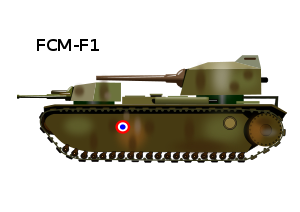The FCM F1 was a French super-heavy tank developed during the Interwar period by the Forges et Chantiers de la Méditerranée company. Twelve were ordered in 1940 to replace the Char 2C, but France was defeated before construction could begin, a wooden mock-up being all that was finished.
The FCM F1 was large and elongated, and had two turrets: one in front and one in the back, with a single high-velocity gun in each turret. The rear turret was higher so it could shoot over the first one.

The vehicle was intended to be heavily armored. Its size and protection level made it early 1940 with about 140 tons, the heaviest tank actually ordered. Despite two engines its speed would have been slow.
The primary purpose of the tank was to breach German fortification lines, not to fight enemy tanks. The development path of the FCM F1 was extremely complex, due to the existence of a number of parallel super-heavy tank projects with overlapping design goals, the specifications of which were regularly changed. For each project again several companies submitted one or more competing
After the Fall of France all official design on heavy/super-heavy tanks was halted. The Char F1 showed quite a few similarities though to the ARL 44, produced just after the war. In 1944 the Allies had developed some new vehicles with exactly the same purpose as the FCM F1: to breach the "Siegfried Line". The British had the Tortoise heavy assault tank, the Americans the Super Heavy Tank T28. Both designs were self-propelled guns however, not multi-turreted tanks, allowing them to be lighter and still better protected. Like the FCM F1 they would not be placed into production.
| FCM F1 | |
|---|---|
 | |
| Type | Super-heavy tank |
| Place of origin | |
| Specifications | |
| Weight | 139 metric tons |
| Length | 10.53 m |
| Width | 3.10 m |
| Height | 4.21 m |
| Crew | 9 |
| Armour | 100 mm |
Main
armament | 90 mm DCA gun |
Secondary
armament | 47mm SA37 gun and six machine guns |
| Engine | two Renault V12 KGM of 550 hp 1100 hp total |
| Power/weight | 7.9 hp/t |
| Suspension | vertical coil springs |
Operational
range | 200 km |
| Speed | 20 km/h |

very good photo, I love the story's behind the super heavy tanks like the mous, total folly, I think the Soviets had some strange super heavy tank based on the KV, but I cant find any photos
VastaaPoistaHello S-K
Poistathank you for your comment
and interest
I will try to explain there lower
Yes, you're right.
PoistaBut, do not worry, they are easy to find
KV-III (3) is a real
KV-VI (4) is a real
KV-V (5) are made
KV-IV, (6) and this is three different reviews
The Allies say no is it imagination or belief
The Germans says they see one of very long monster time of the battle in Moscow
This KV-6 tank was not working, it was broken, not german destroy
The Soviet archives made about 3 pieces.
KV-IIV (7) was also prepared
PoistaHeavy, super heavy...and interesting!
VastaaPoistaHi Phil
PoistaThank you for your comments and for your interest
Yap. Is heavy,
:) but also writer including a heavy serie